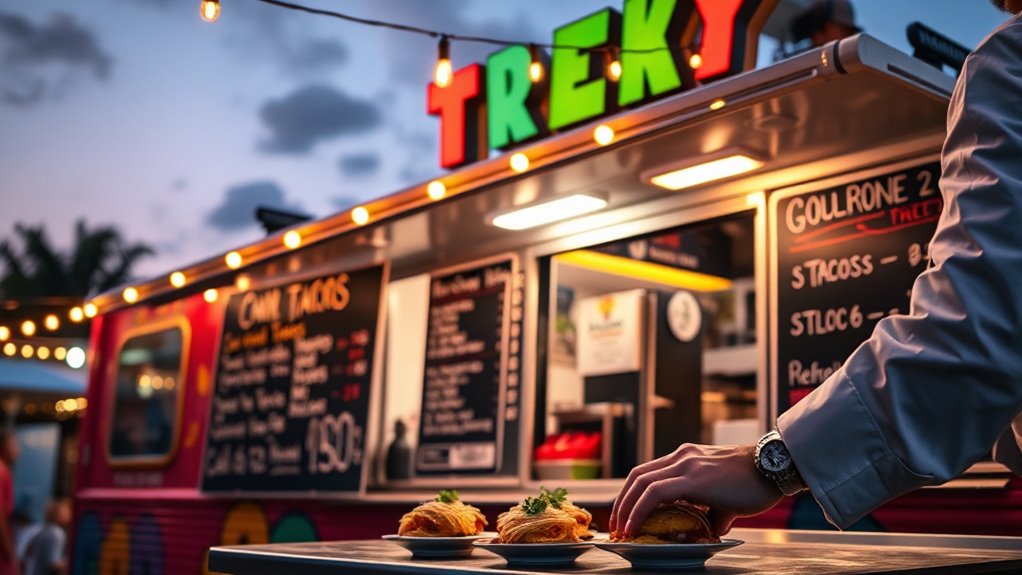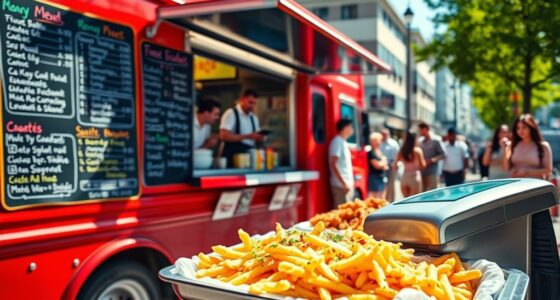To set competitive prices for your food truck dishes, start by calculating all costs, including ingredients, labor, and overheads, then add a reasonable profit margin. Know your target customers’ preferences and spending habits, and analyze local competitors’ prices and menu offerings. Use strategic pricing techniques like charm pricing or discounts to attract customers. Monitor sales and feedback regularly, adjusting prices as needed. Keep exploring these strategies to fine-tune your pricing and stay ahead.
Key Takeaways
- Analyze ingredient, labor, and overhead costs to establish a sustainable base price with desired profit margins.
- Research local competitors’ menu prices and offerings to benchmark and ensure market competitiveness.
- Understand target customers’ preferences, spending habits, and price sensitivity to tailor pricing strategies effectively.
- Use cost-plus and dynamic pricing methods, adjusting for seasonal ingredient costs and demand fluctuations.
- Monitor sales and customer feedback regularly to refine prices, employing psychological tactics and promotional offers for better perception.
Analyzing Your Food Truck’s Expenses
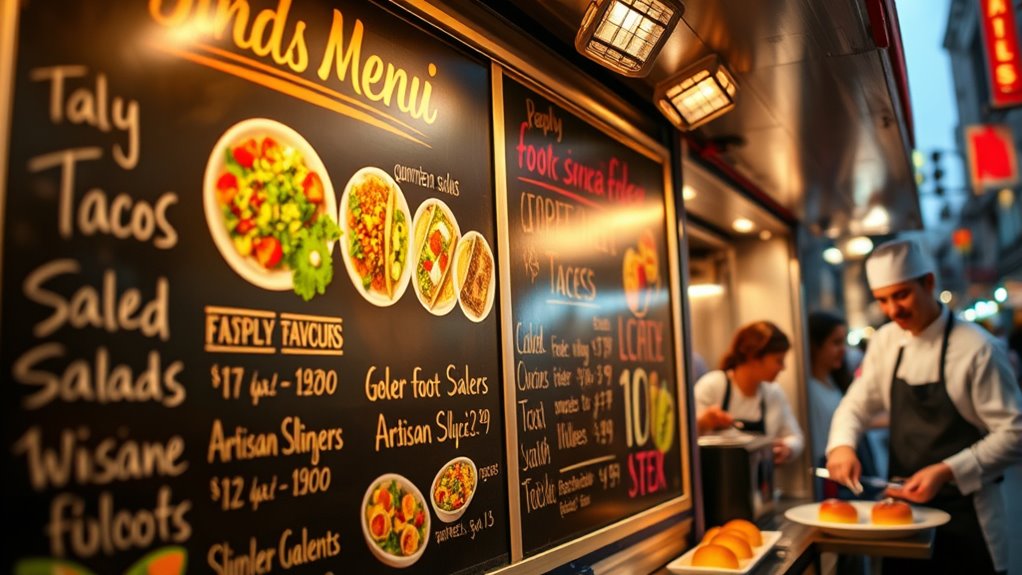
Understanding your food truck’s expenses is essential to setting competitive prices. You need to analyze costs like ingredient sourcing, which directly impacts your profit margins. By carefully choosing suppliers and negotiating with vendors, you can reduce ingredient costs without sacrificing quality. Building strong relationships with vendors helps you secure better deals and discounts, making it easier to keep expenses low. Track every expense related to food, packaging, and supplies to get an accurate picture of your total costs. Don’t overlook small costs—they add up quickly. Knowing your exact expenses allows you to set prices that cover your costs while remaining attractive to customers. Staying informed about industry trends and cost-saving techniques can help you identify additional opportunities to reduce expenses. Stay proactive in vendor negotiations and constantly review your sourcing strategies to maintain healthy profit margins. Incorporating cost-effective fixtures can also help reduce your overall expenses. Implementing mindful budgeting practices ensures that you allocate resources efficiently and avoid unnecessary expenditures. Additionally, considering diverse revenue streams can help stabilize your income and improve overall profitability. Regularly monitoring industry trends and technological advancements can further optimize your operational costs and pricing strategies.
Understanding Your Target Audience

Knowing who your customers are and what they want is essential for pricing your food truck dishes effectively. This understanding allows you to tailor your menu offerings to match their preferences and cultural influences that shape their eating habits. This insight helps you set prices that resonate with their expectations without undervaluing your offerings. Consider these points:
- Identify popular flavors and ingredients based on cultural influences.
- Recognize dietary trends and preferences to tailor your menu.
- Understand spending habits and price sensitivity within your audience.
- Incorporate local food preferences to better align your pricing with customer expectations.
- Additionally, understanding lifestyle factors such as health-conscious choices can help you adapt your menu and pricing strategies to meet evolving customer needs.
- Recognizing the financial impact of audience preferences can further optimize your pricing strategy for better profitability.
- Building an understanding of child-focused preferences can also help in customizing offerings for family-oriented customers.
- Being aware of market volatility and economic shifts can help you adjust prices proactively to maintain profitability and customer satisfaction.
Researching Your Local Competition

Start by identifying the food trucks operating nearby to understand the local scene. Next, analyze their menu offerings and see how they price similar dishes. Comparing these strategies helps you set competitive prices that attract customers without undervaluing your offerings. Additionally, consider the perceived value and presentation of your dishes, much like how acne patches are designed with fun patterns and effective ingredients to appeal to customers and promote healing.
Identify Nearby Food Trucks
To set competitive prices for your food truck dishes, you first need to identify the nearby food trucks that serve similar offerings. Start by exploring local food truck locations, focusing on areas with high foot traffic and events. Visit spots where street vendor regulations allow vendors to operate comfortably. Look for trucks with similar cuisines or menu items to gauge the pricing landscape. Additionally, understanding the types of paint sprayers used by competitors can offer insights into their operational costs and pricing strategies. Consider these tips:
- Check social media and online directories for nearby food trucks.
- Visit their locations during peak hours to observe pricing strategies.
- Talk to other vendors about street vendor regulations and local pricing trends.
- Paying attention to the contrast ratio in their presentation or signage can sometimes provide indirect clues about their branding and marketing budget, which can influence pricing decisions. Moreover, analyzing the maintenance practices of competitors can reveal how they manage costs and sustain their operations efficiently, impacting their pricing strategies. Incorporating market demand data can further refine your pricing approach to meet customer expectations and maximize profitability.
This research helps you understand your competition and set prices that attract customers without undervaluing your offerings.
Analyze Menu Offerings
Examining the menu offerings of your local competitors reveals what types of dishes are popular and how they’re priced. Pay attention to their ingredient sourcing—see if they emphasize fresh, local, or unique ingredients, which can justify higher prices or inspire your own sourcing strategy. Notice if they update their menus seasonally, offering a seasonal menu that appeals to customers seeking fresh, timely options. Analyzing their variety and presentation helps you identify gaps or trends in the market. This research shows which dishes resonate with your target audience and how competitors structure their pricing based on ingredient sourcing and seasonal offerings. Additionally, understanding market trends or aquatic themes in presentation and ambiance can help you create a distinctive dining experience that attracts customers. Incorporating consumer preferences into your menu development ensures that your offerings meet current demands and stand out from competitors. Use this insight to develop a menu that stands out and sets your prices competitively while maintaining quality and freshness. Observing how competitors utilize ingredient sourcing strategies can also inform your decisions on menu pricing and menu design. Recognizing the importance of visual presentation in attracting customers can further influence your dish pricing and overall menu appeal.
Compare Pricing Strategies
Researching your local competition’s pricing strategies provides valuable insights into how similar food trucks position their dishes in the market. Pay attention to how they set prices based on ingredient sourcing and seasonal pricing, which can fluctuate throughout the year. By comparing their prices, you can identify opportunities to differentiate your offerings. For example, some trucks might charge more for dishes made with premium ingredients or during peak seasons, while others keep prices steady to attract budget-conscious customers. Consider these factors:
- How they incorporate ingredient sourcing into their pricing
- How seasonal pricing impacts their menu
- Whether they offer promotions or discounts during certain times
Understanding these strategies helps you find a competitive edge and set prices that resonate with your target audience without undervaluing your dishes. Additionally, analyzing well-being tips related to maintaining quality ingredients can help you sustain high standards without overpricing. Incorporating spiritual energy awareness into your business approach can also foster a more harmonious and intuitive decision-making process. Integrating personality traits such as adaptability can also support your ability to respond to market changes effectively. Being aware of cost management techniques can further ensure your pricing remains profitable while remaining attractive to customers.
Choosing a Pricing Strategy

To choose the right pricing strategy, you need to evaluate your competitors’ prices and understand your costs. Using methods like cost-plus pricing can help guarantee you cover expenses while staying competitive. You might also consider dynamic pricing techniques to adjust prices based on demand and time of day.
Analyzing Competitor Prices
Understanding your competitors’ prices is essential when choosing a pricing strategy for your food truck dishes. By analyzing their prices, you can identify market trends and set competitive yet profitable prices. Look at how they source ingredients—do they use premium or local ingredients? Consider seasonal pricing, as dish prices may fluctuate with ingredient availability. This insight helps you position your offerings effectively. Keep these points in mind:
- Compare portion sizes and ingredient sourcing to ensure fair pricing.
- Note if competitors adjust prices seasonally or for special events.
- Recognize whether they charge premium or budget-friendly prices for similar dishes.
This analysis helps you decide whether to adopt a competitive, value-based, or premium pricing approach that aligns with your target market.
Cost-Plus Pricing Method
The cost-plus pricing method involves adding a fixed markup to the total cost of producing each dish to determine its selling price. This approach simplifies pricing decisions, especially when accounting for ingredient sourcing costs. By accurately calculating ingredient prices, you guarantee each dish covers expenses and yields a consistent profit margin. If you diversify your menu, this method helps maintain profitability across various offerings. You can set a standard markup percentage, making adjustments based on ingredient sourcing costs or dish complexity. It’s a straightforward strategy that keeps pricing transparent and manageable. However, remember that this method doesn’t consider competitor prices or customer demand directly, so you might need to adjust your markups to stay competitive while ensuring your food truck’s profitability.
Dynamic Pricing Techniques
Choosing a dynamic pricing strategy allows you to adjust your food truck’s prices in real-time based on demand, time of day, or special events. This flexibility helps maximize profits and attract more customers during peak times. For example, you might offer seasonal discounts during holidays or slow seasons to boost sales. Promotional bundles can encourage customers to buy more, increasing overall revenue.
Consider these tactics:
- Offer seasonal discounts that align with holidays or weather changes
- Create promotional bundles to increase average order size
- Adjust prices during busy events or festivals to capitalize on high demand
Using these techniques, you can stay competitive and responsive to market fluctuations, ensuring your food truck remains profitable and appealing to customers.
Considering Perceived Value and Quality
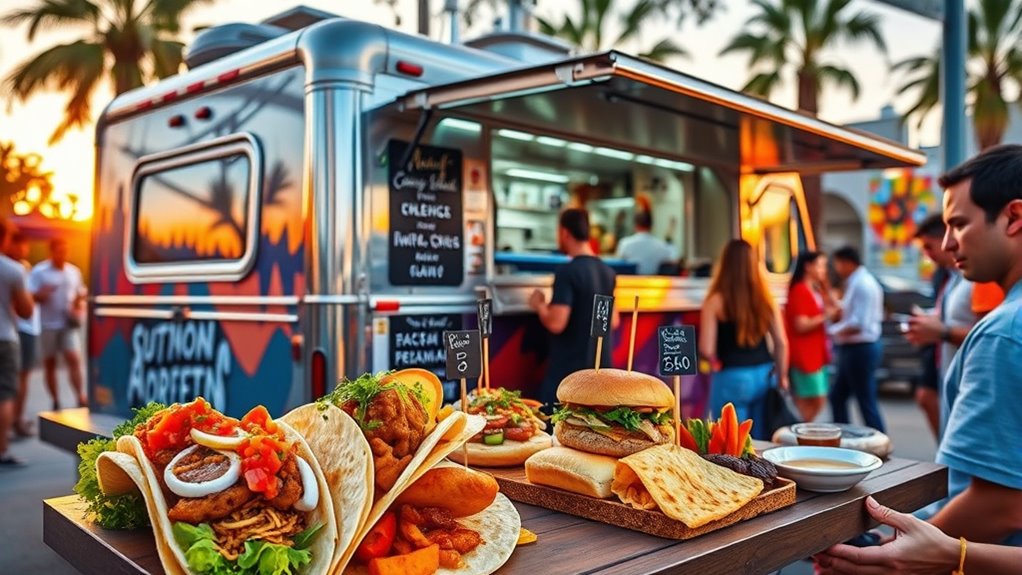
When setting prices for your food truck dishes, you need to take into account how customers perceive the value and quality of what you offer. High ingredient quality and strong branding perception can justify higher prices, as customers associate these factors with better experiences. To understand this better, consider the following:
| Perception Factor | Impact on Price | Customer Expectation |
|---|---|---|
| Ingredient Quality | Higher perceived value | Premium taste and freshness |
| Branding Perception | Trust and loyalty | Consistent quality, memorable experience |
| Dish Presentation | Visual appeal | Enhanced perceived quality |
| Service Experience | Customer satisfaction | Willingness to pay more |
Focusing on these elements helps align your prices with customer expectations, emphasizing perceived value over mere costs.
Testing and Adjusting Your Prices
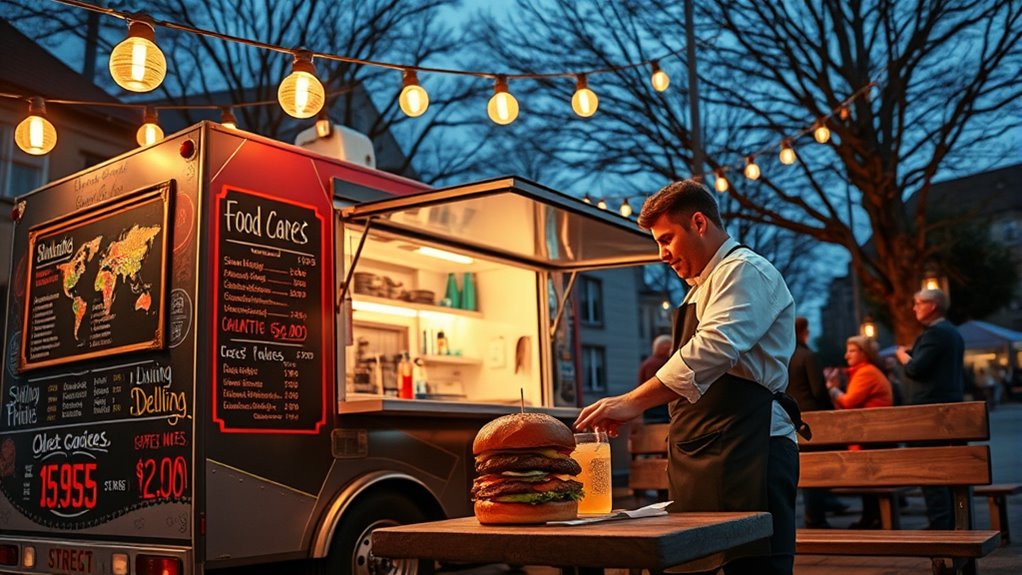
Testing and adjusting your prices is essential to find what works best for your food truck. You need to monitor how customers respond and be ready to tweak your prices accordingly. Pay attention to ingredient sourcing, as fluctuating costs can impact your margins. Incorporate seasonal pricing by adjusting prices based on ingredient availability and demand. This helps you stay competitive while maintaining profitability. Consider trying these strategies:
- Track sales data and customer feedback regularly
- Adjust prices during peak seasons or when sourcing ingredients at lower costs
- Experiment with small price changes to gauge customer reactions
Communicating Your Prices Effectively
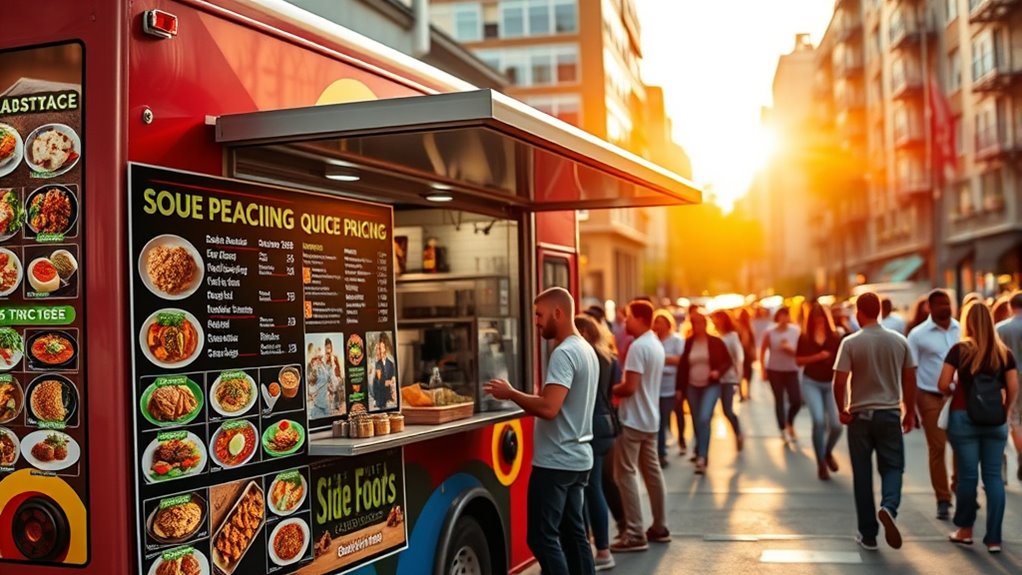
Clear communication of your prices is essential for building trust and encouraging sales. When customers understand your pricing, they’re more likely to feel confident in their purchase decisions. Use pricing psychology by positioning prices strategically, such as ending prices with .99 to appear more attractive. Consider highlighting promotional discounts clearly to attract attention and show value. To visualize ideas:
| Method | Benefit |
|---|---|
| Clear signage | Avoid confusion, promote transparency |
| Highlight discounts | Increase perceived value |
| Consistent pricing | Build trust and professionalism |
| Simple menu layout | Make prices easy to find |
Monitoring Market Trends and Customer Feedback

Keeping a close eye on market trends and customer feedback allows you to stay ahead of industry shifts and meet your customers’ evolving preferences. By monitoring seasonal pricing, you can adjust your menu prices during peak or slow seasons, maximizing profit and customer satisfaction. Customer feedback reveals what dishes resonate most, helping you refine your offerings and pricing strategies. You can also explore bundling strategies, offering combo deals that encourage higher spending while providing value. Regularly analyzing these insights helps you identify emerging food trends, price sensitivities, and popular combinations. This proactive approach ensures you’re competitive, relevant, and aligned with customer desires. Staying attuned to the market allows you to make informed decisions that boost sales and foster loyalty.
Frequently Asked Questions
How Do Seasonal Changes Affect Food Truck Pricing Strategies?
Seasonal changes impact your food truck pricing strategies by affecting seasonal ingredient costs and weather-driven demand. When ingredients are in abundance, costs drop, allowing you to competitively price dishes. Conversely, in off-peak seasons, costs may rise, so you might need to adjust prices or offer specials to attract customers. Additionally, weather influences demand; on hot days, you can capitalize on higher sales, while cold days may require discounts or promotions.
Should I Offer Discounts or Promotions to Attract More Customers?
You should consider using discount strategies and promotional offers to attract more customers. Offering limited-time discounts or bundle deals can create urgency and boost sales. Make sure your promotions highlight value without eroding your profit margins. By actively engaging customers with appealing discounts, you increase foot traffic and build loyalty. Just be strategic—plan your promotional offers carefully to maximize benefits and guarantee they support your overall pricing and marketing goals.
How Can I Price New Menu Items Competitively?
When pricing new menu items, you should consider pricing psychology and conduct a thorough cost analysis. Understand how customers perceive value and set a price that feels fair yet competitive. Analyze your costs carefully to guarantee profitability. Look at competitors’ prices and identify gaps or opportunities. By balancing these factors, you can price your new dishes attractively, encouraging sales while maintaining healthy margins.
What Legal Regulations Impact Food Truck Pricing?
They say “knowledge is power,” and understanding legal regulations influences your food truck pricing. You must adhere to licensing requirements, which dictate how you can price your dishes, and prioritize food safety to avoid fines or closures. State and local laws may impose price controls or transparency rules. Staying informed ensures you’re competitive and legal, helping your business thrive while protecting your reputation and customers’ trust.
How Does Location Influence Optimal Dish Pricing?
Location plays a vital role in determining your ideal dish pricing. You need to take into account parking restrictions, which can limit your customer flow and influence pricing strategies. Additionally, understanding local demographics helps you gauge what customers are willing to pay. By analyzing these factors, you can set competitive, profitable prices that attract more patrons while respecting community regulations and preferences. This approach guarantees your food truck remains both popular and compliant.
Conclusion
By blending your expenses, knowing your audience, and watching the competition like a hawk, you craft a pricing map that guides hungry customers to your food truck’s doorstep. Think of your prices as the seasoning—just enough to entice without overwhelming. Keep testing, listening, and adjusting—like tuning a fine instrument—to guarantee your prices hit the perfect note. With this harmony, your food truck will stand out, drawing customers in like a lighthouse guiding ships home.
